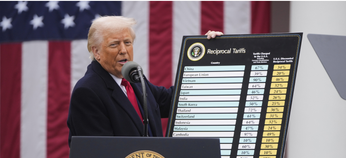
Russia’s de-dollarization delusion
Hello! This is your weekly guide to the Russian economy — brought to you by The Bell. Our story this week is a look at the issue of de-dollarization — something Russia has experienced since launching its full-scale invasion of Ukraine and being hit with Western sanctions. Russian politicians have said for years they wanted to achieve de-dollarization of the economy, but the reality has turned out not to be much fun.
Instead, the replacement of the U.S. dollar and the euro by the Chinese yuan and Indian rupee has caused a whole series of problems. One solution might be if the BRICS group of developing nations introduced a single currency — an idea that Russia is particularly keen on. But there are formidable obstacles to this actually happening.
What’s wrong with using the yuan and the rupee?
The U.S. dollar and euro were used to pay for 30% of Russian exports in July (compared to 87% before the war). On the one hand, by continuing to trade in euros or U.S. dollars, Russian companies make themselves more vulnerable to Western sanctions. On the other hand, switching to the rupee or the yuan is far from ideal due to problems with conversion, risk management and capital flow.
The problems with using rupees to buy Russian crude are a classic example. After the European oil embargo, India became the biggest buyer of Russian oil. That led to a radical imbalance in trade between the countries: in the first half of 2023, Russian exports to India were worth $30 billion, while imports were just $7 billion. Russian exporters are paid in Indian rupees, which is only partially convertible and literally has nowhere to go — at the moment, most of the money is just sitting in Indian banks. Many believe this was a major reason for the ruble’s collapse over the summer. Others feel the “rupee problem” is overstated. Either way, it is a direct consequence of the de-dollarized Russian economy.
The myth of the single BRICS currency
One solution to this problem is the Holy Grail of anti-Americanism — the introduction of a single currency for the BRICS countries of Brazil, Russia, India, China and South Africa. However, most believe that, even as this geopolitical club expands, a single currency is either an impossible dream or an expensive political sleight-of-hand.
Last week’s BRICS summit was interesting not so much because of what happened (offering membership of the group to Iran and Argentina, Saudi Arabia, the United Arab Emirates (UAE), Ethiopia and Egypt) but what didn’t. There was a total absence of any discussion of the previously-announced BRICS single currency.
Politicians in all BRICS countries have long talked about a single currency — although there has been little action. The idea is particularly popular among more anti-Western countries, who regard the U.S. dollar, euro and other Western currencies as instruments of neo-colonialism, or a means of inflating financial bubbles.
Putin said last year that BRICS countries were discussing the creation of an international reserve currency. Brazil’s president Luis Inacio Lula da Silva has also spoken in favor of the idea. South Africa’s Foreign Minister Naledi Pandor in January backed the creation of a single currency to finance projects between member countries and reduce dependence on Western currencies. In March, a nationalist member of the Russian parliament, Alexander Babakov, even went as far as to say that BRICS would print its own currency backed by land and rare metals. The U.S. dollar and the euro, he claimed, “are not backed by anything.”
What would such a single currency look like?
At one end of the spectrum, we have a true single currency like the Euro. But this cannot be replicated. There is no free movement of capital between BRICS countries since the authorities in Russia, China and India all restrict cross-border currency operations to varying degrees and their currencies are only partially convertible. There is also no free movement of labor between these countries. More importantly, the BRICS countries — apart from India — are on synchronized economic cycles that are driven by China’s demand for raw materials. And, while inflation in China is stable, in other countries it is not — which means the Central Banks cannot synchronize monetary policies. Any political decision to introduce a single currency would cost China dear.
A more realistic possibility is a synthetic unit, like the European Currency Unit (a precursor to the Euro). A closer parallel might be the International Monetary Fund’s Special Drawing Rights (SDR). Much like the SDR when it was created in 1969, a BRICS unit of account could be based on a basket of currencies from participating countries. It could then be used to settle accounts instead of the U.S. dollar, euro, yuan or ruble.
Theoretically, it would be possible to introduce a specific unit of account that is not backed by anything, and use it to get away from pricing in U.S. dollars. But this does nothing to encourage de-dollarization — and, ultimately, is more or less the same as bartering.
What are the obstacles?
The major problem is political. India is unlikely to agree to a single currency that would be dominated by China, the largest BRICS economy (up to now, India has striven to contain its powerful neighbor). Russia would benefit from a BRICS currency, since it would gain access to a new reserve currency at a time when sanctions are boxing it in. But the other BRICS members do not have this problem, so the benefits for them would be minimal.
Another problem lies within the trade structures of BRICS. India and South Africa run a trade deficit, and using a single reserve unit would deplete their own reserves unless they could ensure a flow of revenues from outside. For Russia, that would be helpful in its current circumstances, but it would be hard to get its partners to agree.
And there is a final significant problem. Exporters in countries outside Russia that are not affected by sanctions can happily receive U.S. dollars or euros and exchange them for their national currencies. A new unit of account would require a newly-created market where the Central Banks of the BRICS countries would inject liquidity by buying and selling the new unit — while remaining unable to carry out emissions.
Why the world should care
An appetite for de-dollarization is fed only by political issues (particularly being on the receiving end of sanctions). Economists seem convinced that the obstacles are so significant that the U.S. dollar will remain the key currency for international trade and exchange for the foreseeable future. And boosting trade in national currencies leads not to the de-dollarization of the global economy — just to competition between “lesser” currencies.
Key figures
The Russian government introduced Friday export duties of 7% on a number of fertilizers. The previous tariff, linked to the export price, was due to expire at the end of this year, however, fertilizer prices have been lower than anticipated. Now, the tax bill for fertilizer exporters will not be linked to the prices on foreign markets.
Between Aug. 22 and Aug. 28, weekly inflation slowed from 0.09% to 0.03%, according to the Ministry of Economic Development. Annual inflation is running at 5.03%. Unemployment reached a new low of 3%, while salaries and household incomes continued to rise.
Real wages went up 10.5% in June (13.3% in May). Rising real wages are driving increased consumer demand, which went from 9% year-on-year to 9.2% year-on-year.
Further reading
The Bank of Canada looks at the state of current Western sanctions on Russia:
Adam Tooze, an economic historian at Columbia University and author of the “The Wages of Destruction,” a study of the economy of Nazi Germany, analyzes the Russian economy
A conversation about Ukraine’s future with historian Stephen Kotkin



PAID SUBSCRIPTION LAUNCH
From May 1, 2025, The Bell in English will no longer be free
From May 1, 2025, all The Bell’s newsletters and online content will be behind a paywall. We have taken this decision so that The Bell can remain financially independent, and maintain our high standards of journalism and economic expertise






